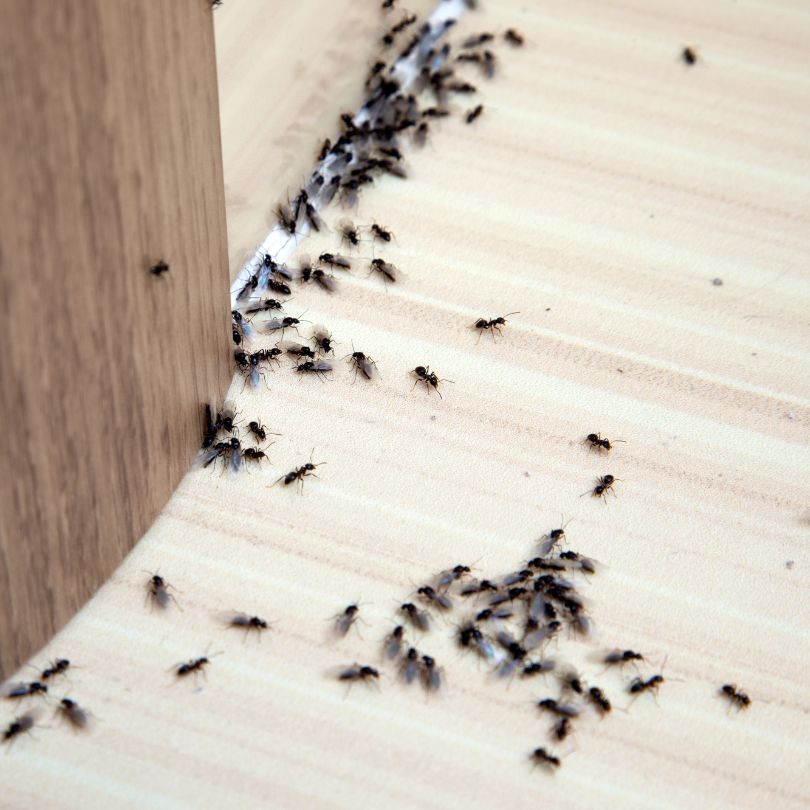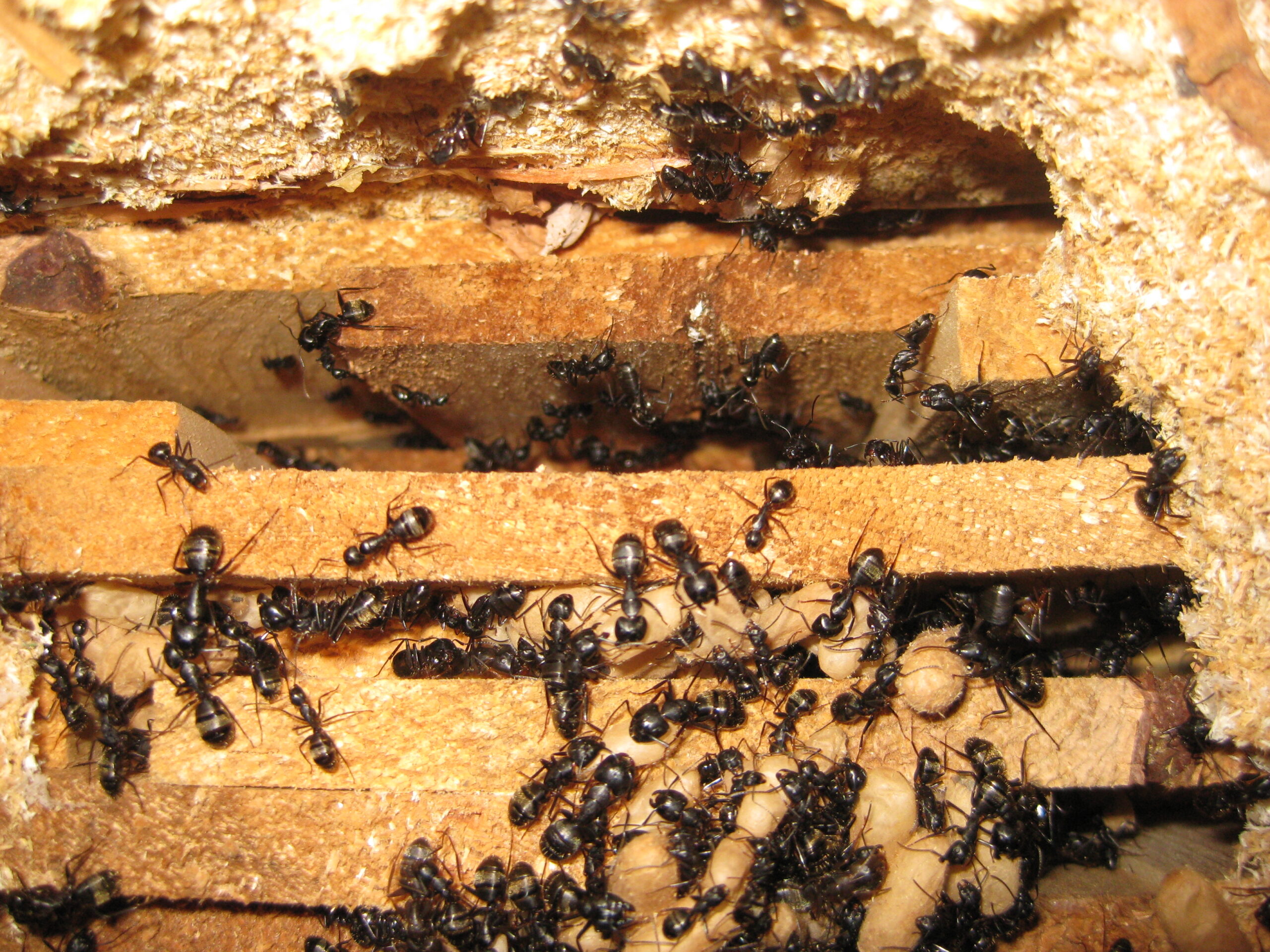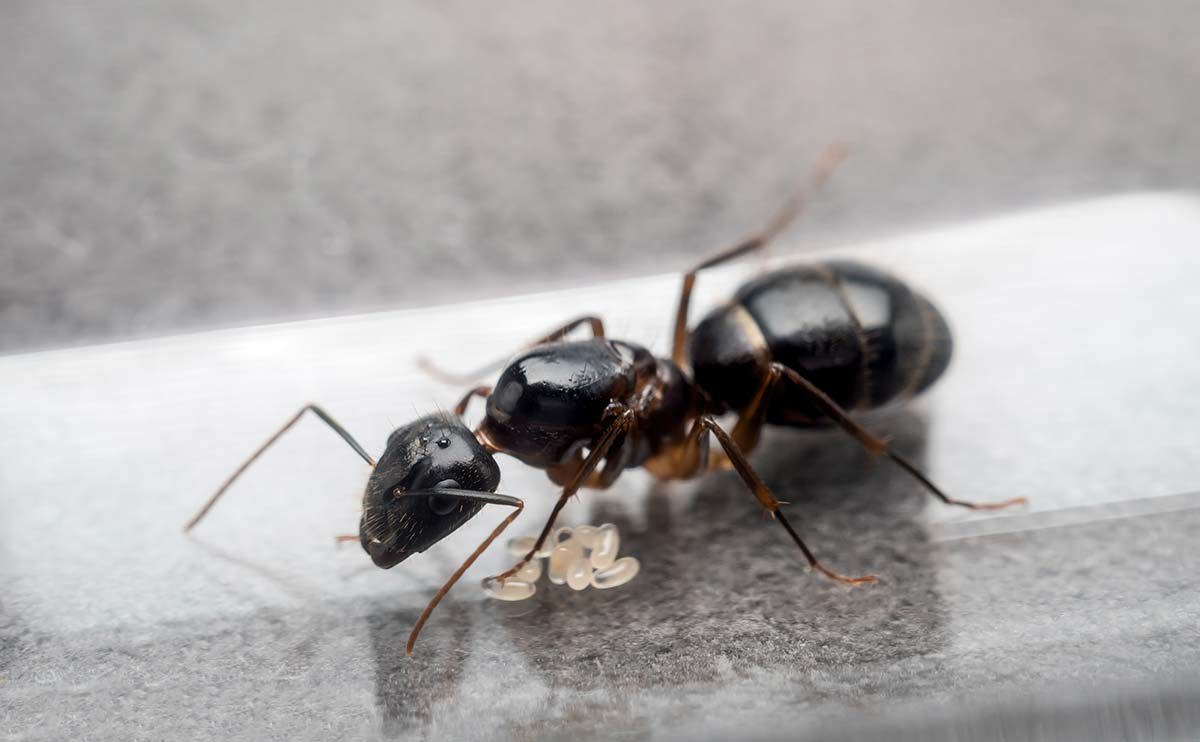Ant Removal and the Types of Ants in Ohio
Pest Control Xperts Services for Oxford, Including Somerville and Camden
Ants are among the most frequently seen pests in homes or businesses across Ohio, including those located in Oxford. Although many ant species contribute positively to the outdoor environment by aiding in soil aeration or preying on other pests, their presence indoors often frustrates property owners. A few ants around the kitchen trash can or near baseboards may look harmless, but these insects can form large colonies out of sight, sending worker ants for scraps of food or water. Some types, such as carpenter ants, tunnel into damp wood over time, creating potential problems for structural supports. Others, like pharaoh ants or odorous house ants, split their colonies if threatened by random sprays, leading to multiple smaller nests scattered throughout a building. Pest Control Xperts offers professional ant removal in Ohio aimed at eradicating entire colonies, not just the surface foragers. By bringing in an experienced exterminator in Oxford, property owners gain a comprehensive plan that addresses the species of ant involved, removes conditions attracting them indoors, and prevents illusions of short term success undone by hidden nests.
Some rely on minimal do it yourself actions, such as wiping counters regularly or placing a few ant traps on windowsills. These small efforts may kill some visible ants but rarely reach the mother queens or sub colonies in wall voids or damp basements. Over a few days or weeks, new lines of ants reappear, revealing that the deeper problem was never solved. A professional approach from Pest Control Xperts locates entry points, identifies which ants occupy the structure, and uses the right baits, dust, or liquid treatments to eliminate entire colonies. This page explores why ants frequently take up residence in Oxford and neighboring towns like Somerville and Camden, the various ant species in Ohio, the troubles ants can bring, signs that an infestation is growing, and how an advanced exterminator strategy guarantees that no leftover ants or queens remain to restart the infestation.
Why Ants Are Common in Oxford, Somerville, and Camden
Ants thrive on small amounts of food and moisture, making certain features of local homes or businesses particularly inviting. Several key factors in these Ohio communities drive ant issues if not addressed:
- Frequent Access to Food
Ants only need small crumbs or a few drops of sugary liquid daily to sustain a colony. Properties that leave food in thin containers, skip thorough sweeping in corners or under furniture, or let pet kibble sit out overnight inadvertently fuel ant foraging. Ants deposit a chemical trail that helps other workers follow the path to these reliable scraps. - Moisture or Damp Wood
Carpenter ants, for instance, choose water damaged or rotting wood for nesting. Even a slow leak under a sink or humidity in a basement may keep wooden beams damp enough for ants to excavate galleries. Owners who repair major breaks but ignore smaller drips can let a carpenter ant colony develop quietly. - Unsealed Entry Points
Tiny cracks around windows, doors, or utility lines often allow ants to slip indoors, searching for food. A property may appear sealed, yet ants can squeeze through minimal openings. Once inside, they establish trails in baseboards or wall voids, quickly forming multiple sub colonies if the species is prone to nest splitting. - Partial or Random Tactics
Many people respond to a few ants by spraying store bought insecticides along windowsills, killing some visible workers. However, if the main nest remains hidden, fresh ants replace those lost. Some ants, like pharaoh ants, respond to sprays by budding into new colonies, causing the problem to spread further across the property. - Neighboring Infestations
Ant colonies sometimes cross yard boundaries or move through shared walls in multi unit buildings. One owner might see short term improvements undone if a next door property does nothing about its own ant issue, driving ants to relocate next door for easier conditions.

Types of Ants in Ohio
Ohio hosts various ant species, each requiring unique strategies for removal. A professional exterminator in Oxford can identify which ants are present, ensuring the right approach is selected:
- Carpenter Ants
These large ants can be black or black and red, measuring up to half an inch. They excavate damp wood rather than eat it, leaving behind small piles of sawdust known as frass. Over time, they may weaken beams or window frames if moisture problems go uncorrected. Spotting small wood shavings near baseboards often signals carpenter ants are active inside walls. - Odorous House Ants
Small, dark brown or black ants that produce a foul smell when crushed, sometimes compared to rotting coconut. Odorous house ants easily split colonies if disturbed by random insecticides. Targeting them typically involves sweet based baits that worker ants share with the entire nest. - Pavement Ants
Usually nesting under sidewalks or driveways, these ants often enter buildings in search of crumbs. Owners frequently see small soil piles near cracks. If the nest extends under floors, minimal surface cleaning does little to halt the main colony from producing more worker ants. - Pharaoh Ants
Very small, yellowish ants that maintain multiple queens. Spraying them without strategy can cause budding, where segments of the colony break off, forming new nests. Professional baiting is the recommended approach to eliminate every queen and ensure total collapse of the colony. - Field Ants
Common in lawns, forming mounds outdoors. Although they prefer open fields, changes in weather or yard conditions may push them closer to buildings for moisture or minimal food scraps. Addressing their outdoor nests plus potential entry points is essential to keep them from crossing inside.
Identifying the species is critical. Each type differs in nesting preferences, foraging habits, and bait or treatment preferences. Using the wrong approach may yield illusions of progress undone by hidden queens continuing to produce more ants.
Problems Ants Cause Indoors
Though ants do not typically pose direct health threats like some pests, a large colony can lead to many disruptions:
- Food Contamination
Ants crawl over counter tops, inside pantries, and even in stored items. Families or businesses might discard goods if ants reach them. Restaurants, offices, or retail stores see brand reputation harm if customers spot ants in dining or product areas. - Carpenter Ant Damage
Carpenter ants undermine structural strength when they tunnel into rotted beams or frames. Though they do not consume wood like termites, their galleries cause enough hollowing that floors can sag or window framing warps. Repairs can add up fast if the infestation goes on for months. - Daily Irritation and Cleanup
Discovering lines of ants each morning can be demoralizing if cleaning the prior evening seemed thorough. Minimal insecticide spraying kills a few foragers but does not reach the hidden nest. Over time, owners tire of illusions undone by leftover ants replacing those lost. - Allergy or Stress Concerns
Some people prefer to avoid any insects around food or children. Worrying about ants near pet bowls or in bathrooms disrupts day to day comfort. Although not as dangerous as certain pests, their presence still undermines peace of mind. - Sub Colonies
Species like pharaoh ants or odorous house ants respond to standard sprays by creating new nests. That means a single large colony can become multiple satellite nests scattered behind walls if threatened, making professional coverage essential.

Indications an Infestation Is Growing
Ants stay behind walls or in damp corners, so owners watch for these signs that a colony is expanding:
- Steady Ant Lines in More Than One Room
Noticing ants in kitchens, bathrooms, or basements simultaneously indicates multiple infiltration routes. A partial approach only removing ants seen in the kitchen may not halt the nest behind the wall near a bathroom. - Sawdust near Damp Wood
Carpenter ants produce small piles of wood shavings around windowsills or baseboards. Spotting this debris signals a nesting site inside rotting beams. Spraying the surface seldom removes the main colony if moisture remains. - Winged Ants Emerging Indoors
When an ant colony matures, it produces swarmers with wings. Finding them near windows or doorways can confirm an established colony that is ready to expand or reproduce further. - Odor When Crushing Ants
Odorous house ants emit a strong, musty odor if squashed. Smelling this multiple times after wiping up ants means they likely maintain multiple nest areas that require targeted baits. - Nests or Mounds Outdoors
Ants nesting under sidewalks or in field mounds near the foundation may move indoors for scraps or moisture if left undisturbed. Some owners see them near yard edges daily and discover them inside later on.
Why an Exterminator in Oxford Is Vital for Ant Removal in Ohio
While basic do it yourself actions offer short term relief, advanced strategies eliminate the queen or multiple queens, guaranteeing no leftover ants:
- Accurate Species Identification
A specialist recognizes if the ants are carpenter, pharaoh, odorous house, or pavement ants, selecting the right baits or dust. Using the wrong tactic can scatter certain ants, forming more colonies. - Safe, Targeted Treatments
Instead of spraying across floors, an exterminator in Oxford places baits in runways ants must cross. Families generally stay home, avoiding fresh products until dryness. By focusing on corners or nest sites, the queen ingests lethal materials carried by worker ants. - Moisture and Food Solutions
Carpenter ants vanish if rotted wood is replaced or leaks are addressed. Storing sugar or cereals in sealed containers robs ants of daily scraps. Professionals guide owners on dryness or leftover disposal to hamper new foragers. - Destruction of Entire Colonies
When worker ants carry bait back, it spreads to each queen. That difference prevents illusions undone by leftover queens producing new eggs. The entire nest collapses over days or weeks, rather than a few foragers being replaced soon after. - Follow Up Checks
Some ants can have multiple sub colonies or budding. If lines reappear, a second look addresses hidden pockets or new expansions. Professionals finalize coverage once no further sightings or frass emerges for a set interval.
Pest Control Xperts Ant Removal Process
Our program tackles every step, from species verification to ensuring no hidden nest remains:
- Consultation and Inspection
We talk with owners about suspicious sightings or frass piles, then examine kitchens, bathrooms, basements, or yard edges to find main nests or infiltration routes. Determining the species directs the next steps. - Tailored Bait or Dust Selection
Carpenter ants often require protein based baits or direct dust in damp wood, while odorous house ants do best with sweet baits. By matching the method to the species, the entire colony, including queens, is eliminated efficiently. - Precise Application
Families remain onsite, simply avoiding newly treated zones until dry. Baits go in corners, under appliances, or near known runways. Worker ants bring the poison back to hidden queens, wiping out the nest from within. - Moisture or Leftover Fixes
If rotting beams exist, they might need replacement to fully remove carpenter ant nesting. Sealing cracks around foundations or storing cereals in sturdy plastic bins helps hamper new ants trying to enter. These minor improvements keep the property less appealing to fresh invasions. - Monitoring and Validation
If owners spot more ants soon after, we recheck for overlooked sub nests. The process ends only once no sightings or frass occur for a set period. This confirmation spares illusions undone by eggs or budding nests in corners.

Why Oxford, Somerville, and Camden Rely on Pest Control Xperts
Customers in these Ohio communities choose our ant removal in Ohio for clear reasons:
- Local Insights
An exterminator in Oxford understands local building styles, damp conditions, and typical infiltration points for ants. This knowledge speeds up detection and ensures each approach is thorough. - Complete Colony Eradication
We target the entire population, from worker ants to queens. That difference spares owners illusions undone by leftover ants soon refilling lines across floors. - Safe, Targeted Use of Products
We avoid broad spraying floors, focusing on corners or nest sites. Families often remain indoors, only avoiding newly placed baits or dust for the recommended window. This approach reduces exposure while still striking the colony effectively. - Maintenance Guidance
Eliminating ants is half the story. We highlight dryness or leftover disposal tasks that hamper new invasions. For carpenter ants, we emphasize rotted wood repairs. This synergy secures long term relief. - Follow Up If Needed
If ants pop up again, we revisit to handle missed pockets or newly formed sub nests. We finish only after a period passes with no new lines, guaranteeing final success. - Professional Communication
We arrive promptly, safeguard each property, and explain steps plainly. Many local owners mention us to neighbors or colleagues, having experienced the difference a comprehensive approach provides.
Contact Pest Control Xperts for Same Day Service
When daily wiping of floors in Oxford fails to stop ant trails, or if property owners in Somerville or Camden notice carpenter ant frass near damp wood, a deeper solution is needed. Pest Control Xperts delivers ant removal in Ohio, identifying each species, placing customized baits or dust that worker ants carry back to queens, and instructing on dryness or leftover management so ants lose their key resources. An exterminator in Oxford concludes the process only after verifying no leftover ants or new lines appear, sparing illusions undone by hidden nests.
Call Pest Control Xperts right away for same day service and end repeated cycles of partial do it yourself attempts that kill a few visible ants but never touch the mother colony. By merging minimal housekeeping tasks, such as sealing up cereals or fixing small leaks, with specialized exterminator strategies, owners remove the entire ant population, from a single large nest to potential sub colonies behind walls. Families, staff, or customers can then walk floors free of trailing insects or concerns about structural damage from species like carpenter ants, confident the property remains fully ant free.
